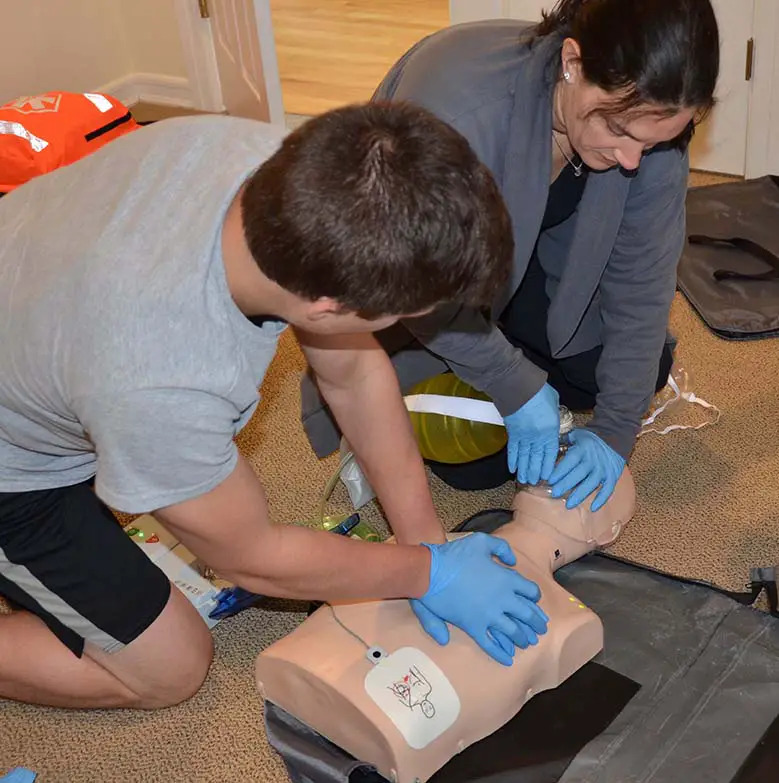Jason Goldberg, owner of the Westhcester-based Accel Health & Safety and an American Safety & Health Institute instructor, shares information about CPR, including what CPR is, why it’s important to take CPR and first aid training courses, and how to administer CPR properly.
 Photo by Jason Goldberg |
| Joe Mastro and Deb Jacobs practice two-rescuer CPR during their CPR Pro class with Accel Health & Safety. |
Can you give a brief description of what CPR is for someone who doesn’t know what it is?
CPR, or cardiopulmonary resuscitation, is the combination of effective chest compressions along with rescue breaths. And the purpose of CPR, which is administered in events of sudden cardiac arrest, is to bridge the gap between the onset of sudden cardiac arrest and the time that more advance medical care arrives. That more advance medical care might be the arrival of an ambulance with an EMT and a paramedic or even arrival of an AED (automatic external defibrillator) which most CPR classes incorporate today.
What are some of the confusions surrounding CPR?
The vast majority of the time, CPR will not restart the heart. CPR bridges the gap between the onset of sudden cardiac arrest and more advanced medical care, or the arrival of a defibrillator.
Some other facts are when you’re performing CPR, you’ll often crack ribs. But if somebody is saved by more advanced medical care and CPR and has a cracked rib, they can heal from that cracked rib. You will also find in studies that if CPR is conducted immediately and a defibrillator is used within a few moments of the onset of cardiac arrest, survival rates are 40 percent.
That may not sound like a lot but the reality is that for every minute that CPR and an AED are not used together when trying to save somebody from sudden cardiac arrest, their chances of survival decrease to 10 percent in 10 minutes. You really only have a maximum of 10 minutes to save somebody and if all goes perfectly, there is a 40 percent chance of survival. It doesn’t sound like a lot, but we’re talking about somebody whose heart has stopped beating or is beating so ineffectively that it’s not sustaining life.
Do you have any tips for the proper way to administer CPR?
Take a class. It’s a few hours out of your time, and it teaches you so much more than just CPR. You will learn so many other life saving techniques from those few hours. So spend the few hours every few years refreshing your skills. It’s not a lot of time, it’s not a lot of money, and if you can use it, it more than pays back.
If you have to perform CPR, don’t use just your arms, use your shoulders and back in the motion. Square your shoulders over the person’s chest, place the palm of your hand right on the breast bone in the center of the nipple line, and compress the chest an appropriate depth depending on the age of the person in using your shoulders and your back. You want to use the entire force of your body—it’s not an easy thing to do, it actually requires quite a bit of force for someone to perform CPR effectively.
On adults, children, and infants in a layperson class, you would perform CPR at a rate of 30 compressions for every two breaths at that rate of at least 100 compressions per minute. On an adult, you would compress at least 2 inches in depth, approximately 2 inches on a child, and approximately 1½ inches on an infant.
Other than knowing the proper way to do CPR, are there any other benefits to taking a certification class? How often should a layperson be re-certified?
There are three reasons. One, you need to know how to recognize the onset of sudden cardiac arrest, heart attack, stroke, allergic reactions, and probably 20 other things to know how to administer the right care and that can only be learned through a class.
Two, there is nothing better than practicing on a mannequin. You’re aware of the concept of muscle memory, where you practice something over and over again and you can just react. In a good CPR course you’re going to run multiple scenarios, and CPR is not just performed in one way.
Three, a general CPR and first aid course will teach you how to be a responder, and CPR is just one component. You’ll learn how to save somebody who is choking, how to recognize the signs of a stroke, what questions to ask if you come across the stranger who simply doubled over on the sidewalk and how to you evaluate what’s wrong with that person, and the cycle of care, and you’ll practice, which is critical.
A quick little story, I was an emergency first responder when I was in college so I’ve been taking these classes for many years. Last summer I was out with my son who was 5 at the time and we went out for lunch to an outdoor restaurant where he decided to inhale a third of a hot dog, bun and all. All of a sudden his eyes went wide, his mouth was wide open, not making a sound, and tears were coming down. If I had not taken a class, I would not have recognized those as signs of choking. I just reacted immediately. I got up, stood behind him, administered abdominal thrusts, and out came the hot dog bun and all. A few minutes later he was fine. You’ve got approximately 60 seconds in a choking scenario before somebody becomes unconscious, so there’s not a lot of time to go back and Google “how do I care for somebody who’s choking”. You have to know what is happening and have somebody show you the proper hand placements to perform those abdominal thrusts so you can save someone without the situation escalating.
In most layperson classes, the certifications are good for two years.
Where and how often are the courses that you hold offered?
I offer a few different types of courses. For laypersons, most of the classes I offer are private, in-home classes. I bring everything to your home, people will invite family members and friends and we’ll hold a class right there. And I find that people enjoy those, it’s done at their convenience and I bring a lot of equipment so I keep the student-to-equipment ratio very low and we’re able to get through the material and make it relevant. And I offer public classes through the Saw Mill Club in Mount Kisco.
I also offer something that I call a CPaRties. We bring the equipment into the home and I’ve got a game that hooks up to a laptop, which we project on the wall. When people want to learn some skills, they’ll have a brunch party or a little dinner party, and we’ll set up in the corner and people can kind of wander over and learn a couple of the critical skills during the party. It keeps it very light, but people can get competitive because they’re playing against each other. The game scores you on how well you’re performing CPR compressions and breaths on the mannequins, so it’s a lot of fun.
Lastly, I offer professional courses, which are given to medical professionals, dentists, lifeguards, EMTs, and swim instructors.
Jason Goldberg is the owner of Accel Health & Safety, which offers CPR and first aid courses for laypersons and professionals. Goldberg is an American Safety & Health Institute instructor Trainer, Emergency First Response instructor, a National Academy of Scuba Educators instructor, and a Professional Association of Diving Instructors professional. For more information, visit accelcpr.com.





















